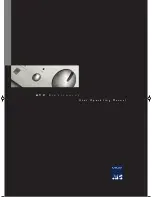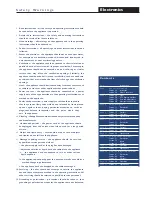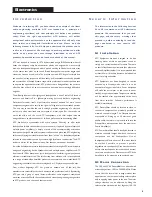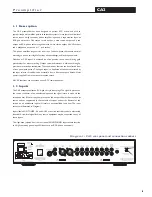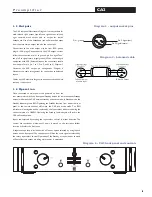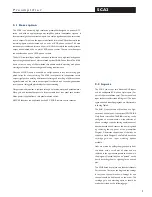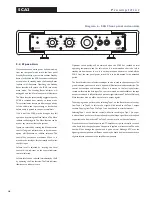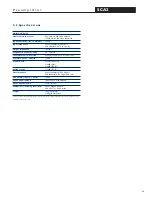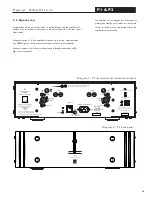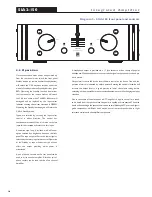
1
1
Electronics
Welcome. In selecting ATC you have chosen an example of the finest
audio engineering available. ATC was founded on a principle of
engineering excellence, and that principle still defines our products
today. Given the right opportunities, ATC products will deliver
exceptional audio performance, but the opportunities will only arise
from careful and thoughtful installation and use. Please read the
following manual fully. It will help you understand the product and to
realise its full potential. We are happy to answer questions and offer
advice on any issues that arise through installation or use of ATC
products. Contact details can be found at the back of this manual.
ATC was founded in London in 1974 by Australian emigre Bill Woodman, who still
heads the company today. An enthusiastic pianist and engineer he was naturally
drawn to loudspeaker design and after a period working at Goodmans, where many
of the names that went on to found British loudspeaker companies began their
careers, he struck out on his own. The premise on which ATC began is a simple one,
and one that in many respects is still true today: hi-fi loudspeakers tend to be detailed
and accurate but of limited dynamic range, while professional monitor speakers tend
to express the opposite character. ATC products were designed from the outset to
offer the best of both. It’s an easy concept to describe, but surprisingly difficult to
engineer.
The difficulty inherent in designing such loudspeakers is one of scale. Hi-fi levels of
accuracy and detail call for lightweight moving parts and delicate engineering.
Professional monitor levels of performance however demand far more robust
components engineered to survive the rigours of high level use for extended periods.
The only way to combine the two is through precision engineering of a class and
scale more often associated with aerospace or motor-sport. But the results are
worth the effort and the cost. ATC loudspeakers, with their unique in-house
designed drivers, combine the best of hi-fi and professional to devastating effect.
ATC has become synonymous with active systems. Choosing to offer active
loudspeakers (where the passive crossover network is replaced by active filters and
multiple power amplifiers) is simply a result of the uncompromising attitude to
loudspeaker design. While passive systems still have their place, and ATC engineering
skills can still bring remarkable results from them, “active” is a fundamentally better
solution to the problems posed by accurate, high level music reproduction. The ATC
instinct is always for the better solution. Not cheaper, not quicker, but better.
It was the development of active loudspeakers that first brought ATC into electronics
design and engineering. Active speakers demand multiple power amplifiers so ATC
from the mid 1980s became not just a loudspeaker manufacturing company but an
electronics manufacturer too. The further step from electronics for active speakers
to a range of stand-alone amplifier products was natural and now means that ATC
engineering is available from the recording desk or CD player output to the ears.
From modest beginnings ATC has grown to become one of the very few
manufacturers successful across both domestic and professional audio. By selecting
ATC you join a group of music lovers, professional audio engineers, studios and
musicians across the World that understand and value the engineering that goes into
an ATC product - and the sound that comes out.
I n t r o d u c t i o n
G e n e r i c I n f o r m a t i o n
The information in the following Sections
G1 to G5 is common to all ATC electronics
products. We recommend that you read
this page, and the safety warnings that
proceed it, before continuing to read the
pages dedicated to your specific ATC
products.
G 1 I n s t a l l a t i o n
ATC Equipment has been designed to be free
standing either within an equipment stand or
simply on a convenient item of furniture. There are
no special ventilation requirements (but please see
notes on Amplifiers below). It is recommended that
at least 100mm (4 inches) clearance be left behind
a unit for plugs and cables.
ATC Equipment has been designed to remain
powered-up in Standby mode unless it is to be
unused for a long period of time. Power dissipation
will make the unit warm to the touch in either
standby or operational mode. Temperature stability
will be reached after approximately three hours
from mains switch-on. Full
audio performance is
available immediately.
ATC Preamplifiers should be located as close to
the source components as practically possible to
minimise the cable length. The Outputs however
are capable of driving up to 50 metres of good
quality cable; therefore it is practical to locate the
Preamplifier a distance away from the monitor or
Power Amplifier(s).
ATC Power Amplifiers should ideally be located to
minimise the cable lengths from both the source
components and the Loudspeakers. Use of
loudspeaker cables in excess of 20 metres should
be avoided if possible to prevent a possible
degradation in sound quality. Care must be taken to
ensure that ventilation holes in the top and bottom
covers are not obscured. Please contact ATC if the
Amplifier is to be mounted in an enclosed area.
G 2 M a
i n s C o n n e c t i o n
The CA2 and SCA2 Preamplifiers can be used with
mains voltages from 100V to 240V, 50/60Hz. Please
ensure that the local mains voltage matches that
uppermost on the rear panel voltage selector plate
before applying mains power to the unit. The mains
voltage selection can be adjusted by lifting the
selector plate marked with four legends (100, 120,

